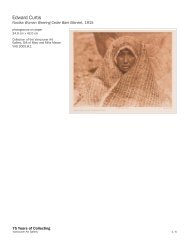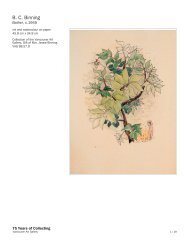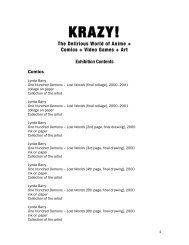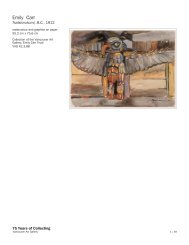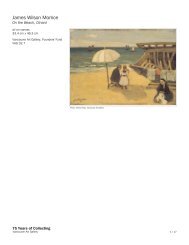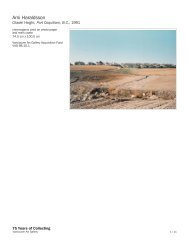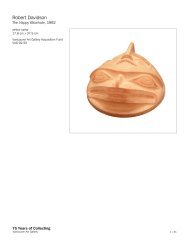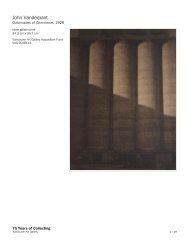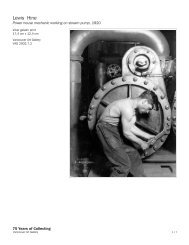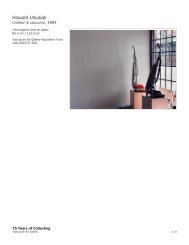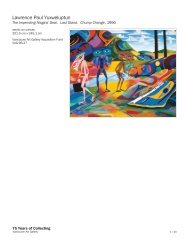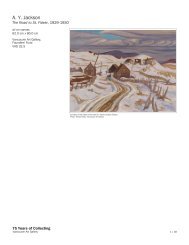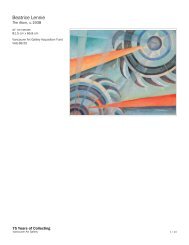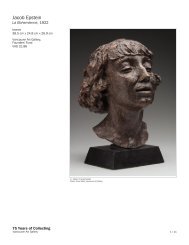Eugenio Dittborn - 75 Years of Collecting - Vancouver Art Gallery
Eugenio Dittborn - 75 Years of Collecting - Vancouver Art Gallery
Eugenio Dittborn - 75 Years of Collecting - Vancouver Art Gallery
Create successful ePaper yourself
Turn your PDF publications into a flip-book with our unique Google optimized e-Paper software.
<strong>Eugenio</strong> <strong>Dittborn</strong><br />
The III History <strong>of</strong> the Human Face (Sydney Camino), 1989<br />
<strong>75</strong> <strong>Years</strong> <strong>of</strong> <strong>Collecting</strong><br />
<strong>Vancouver</strong> <strong>Art</strong> <strong>Gallery</strong><br />
ED An Airmail Painting is the space in which these times meet one another. In<br />
this scene, the hybridization in my work is a temporal hybridization. Signs that<br />
belong to different and distant temporal strata finally meet there, and in<br />
meeting, make one another reciprocally visible. This also has to do with<br />
mediation, that is, with that which makes transfer possible and which travels in<br />
order to transfer particular questions. For example, in the Pieta the first<br />
mediation would be the TV screen on which erupted the image <strong>of</strong> Benny Kid<br />
Paret lying in agony on the canvas at Madison Square Garden. A UPI<br />
photographer photographed the scene from the TV screen, and later the UPI<br />
sent this photo to the Chilean magazine Gol y Gol which printed and published<br />
it. A copy <strong>of</strong> this magazine ended up 15 years later in a secondhand bookstore<br />
where I found it in 1977. I worked for a relatively long time with this photograph,<br />
reprinting it many times. Finally, in the last six years I have used this same photo<br />
in a few <strong>of</strong> the Airmail Paintings. I have a special fascination with images that<br />
carry the traces <strong>of</strong> their successive transfer or signs <strong>of</strong> their travels, as we have<br />
already seen. The figure <strong>of</strong> Benny Kid Paret, dying from the punches <strong>of</strong> Emile<br />
Griffith, was contained on the TV screen, and then a photograph contained the<br />
agonized figure <strong>of</strong> Benny Kid Paret televised. Finally, a magazine printed and<br />
published the multimedia-ized figure <strong>of</strong> the Cuban boxer. That is the model: in<br />
the object itself are visibly, visually inscribed, all the mediations that contained<br />
and transferred it: all its layers.<br />
RM I wanted to go back to the issue <strong>of</strong> the photo encountered in a magazine.<br />
There is nothing else possible, nothing other than dispatching this found object<br />
in order to maintain it as such. The Airmail Painting is not, however, an ultimate<br />
destination. Things come together in it, make themselves seen, and at the same<br />
time, have to continue circulating.<br />
ED Sure, it is as if it was a punishment. This is how they seem.<br />
RM Like a penance ...<br />
ED The penance is to be permanently in movement.<br />
RM Like souls that have no resting place.<br />
ED They have no house and no destiny. All destinations are the house.<br />
RM There is another issue I would like to discuss, which is the following. In the<br />
text for the catalogue to your exhibition at the Australian Centre for Photography<br />
in Sydney (October 1989), the Airmail Paintings are described as "evading the<br />
imperatives <strong>of</strong> the art market ... [they] arrive to unfold and to occupy a<br />
substantial amount <strong>of</strong> the hotly contested space <strong>of</strong> the cultural metropolis."<br />
Now, this question is an important one: how by means <strong>of</strong> airmailness can one<br />
totally avoid that sort <strong>of</strong> pyramid <strong>of</strong> desires and fantasies that accompany the<br />
exhibition <strong>of</strong> one's actual works in the metropolis? In other words, the way in<br />
which your painting converts the metropolis into a place <strong>of</strong> transit, since from<br />
there it is soon sent on to another place <strong>of</strong> transit, giving the metropolis a status<br />
equivalent to the place <strong>of</strong> origin. The metropolis is no longer the place <strong>of</strong> arrival,<br />
the supreme summit <strong>of</strong> the artist's career.<br />
8 / 19



